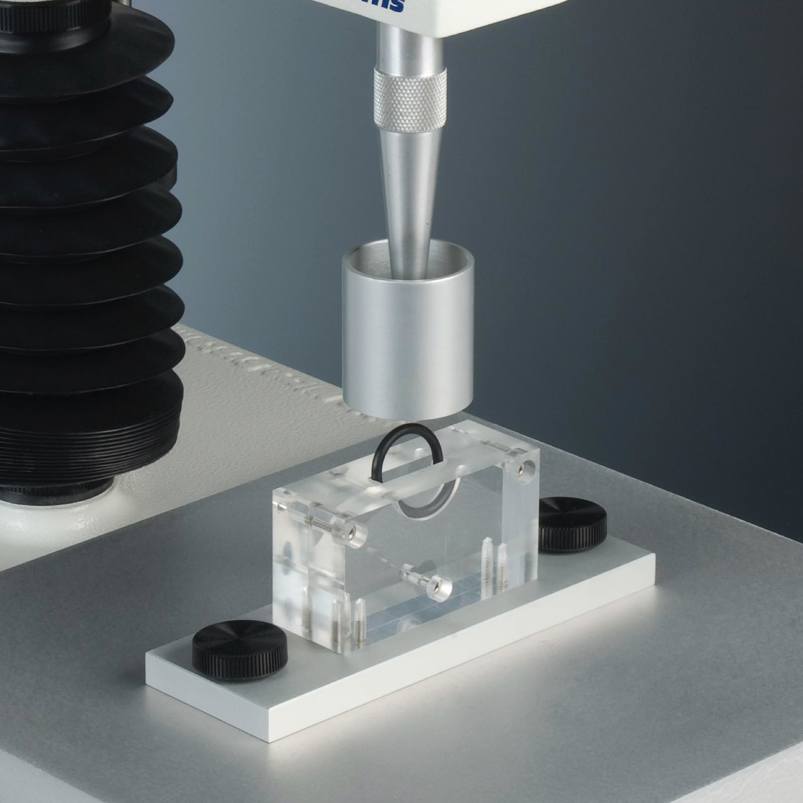Product overview
The Intravaginal Ring Holder is designed for precision testing of vaginal rings (VRs) used in controlled drug release applications, including contraception, hormone replacement therapy, and microbicide delivery for HIV prevention. This holder supports the ring to ensures accurate and repeatable measurements of mechanical integrity, compression strength, and fatigue resistance during repeated cycles. These mechanical property measurements are key factors in VR performance and are ideal for R&D laboratories, regulatory compliance testing, and quality control departments involved in vaginal ring development and manufacturing. Assessment of the mechanical performance of vaginal ring devices is an essential part of the design process, particularly in understanding the effects of different elastomer choices on ring performance.
The Intravaginal Ring Holder is mounted on a Texture Analyser and supports the ring vertically in a groove (bespoke manufacture) to enable repeatable and accurate compression testing. The compression test evaluates the ring’s ability to withstand repeated compression cycles while maintaining its structural integrity which is essential for long-term performance and durability (fatigue resistance) and drug release consistency over time. Usually the force (in Newtons) required to compress ring devices by 5mm is measured and 6 compressions per ring are performed on the Texture Analyser. However, research methods also report testing of the mechanical strength and durability of diaphragm devices involving a test during which the rings are compressed to 25 +/- 5% of their original OD and released 1000 times with recovery acceptance criteria set as at least 90% recovery of the original diaphragm diameter (McBride et al, 2019) In this study, ring holders capable of holding multiple rings simultaneously, were used. To discuss provision of this design, contact Stable Micro Systems.
The compression probe is not supplied as any probe can be used for compression so long as it is larger than the ring diameter. Holders are manufactured to order according to specified ring dimensions.
Ideal sample form
Rigid rings that can be supported vertically so that they can be compressed.
Benefits and limitations
- Provides an imitative test.
- Made to order to accommodate specific VR sizes.
Technical information
Installation
Full installation instructions are provided within the Education Zone of the latest Exponent/Connect software version and on the technical information sheet accompanying this product.
Chemical compatibility
Stable Micro Systems probes and attachments are commonly made from four materials: anodised aluminium (AA6082 T6), stainless steel (316 T), Delrin (acetyl copolymer) and Perspex (polycarbonate).
In general use, probes and attachments made from these materials will be suitable for testing food products and inert non-food materials.
The four materials listed above are not universally resistant to all types of chemicals and as such the compatibility of the probe/attachment material with the product (to be tested) must be established to prevent damage to the probes and attachments. If the compatibility of the product with the probe is unknown to the customer then the chemical information about the product (Material Safety Data Sheet or Product Data Sheet) should be submitted to Stable Micro Systems. Stable Micro Systems will then assess the suitability of the probe/attachment material for use with the product and advise accordingly. If this advice is not sought then Stable Micro Systems will not accept liability for probes/attachments damaged by chemical attack from the product being tested.
Cleaning and maintenance
All probes and attachments may be cleaned in warm (or hand hot) water using a mild detergent. A soft brush may be used but abrasive cleaning aids should be avoided. Stable Micro Systems products should not be microwaved or cleaned in a dishwasher.
Screw threads should be lightly lubricated after drying using a light lubricant, e.g. petroleum jelly, mineral oil. This will aid the fitting and unscrewing of the item. Each component of a probe or attachment should be wrapped separately when stored, to avoid scratching or chipping. This will safeguard against any unnecessary damage to the accessory.

